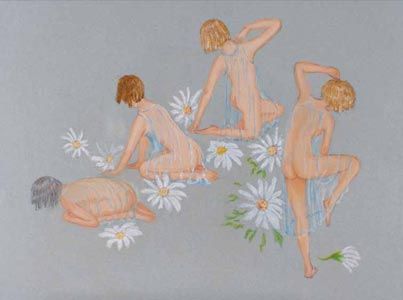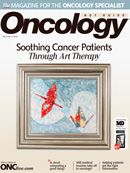Publication
Article
Oncology Live®
Ars Medica: Soothing cancer patients through art therapy
Author(s):
Before Western medicine took root, therapies often tapped both the mind and body to promote healing.
"The natural healing force within each one of us is the greatest force in getting well."
-Hippocrates
The term "psychosomatic," which originates from the Greek terms "psyche" for "mind" and "soma" for "body," refers to anything involving the mind and body, a connection that has been studied since ancient times. Before Western medicine took root, therapies often tapped both the mind and body to promote healing. Examples include meditation, aromatherapy, yoga, and acupuncture, all of which have been historically dismissed by Western medicine, a practice that has largely viewed the mind and body as separate entities. However, studies are increasingly finding such therapies to be beneficial, generating renewed interest in the mind-body connection. Today, mind-body medicine is known by a variety of terms, including "psychosomatic medicine," "holistic medicine," and "alternative medicine," and in addition to reassessing the value of ancient practices such as yoga or meditation, new techniques are being developed, including art therapy. While visual expression dates back to prehistoric man, art therapy became a distinct profession in the 1940s when psychiatrists and educators independently discovered art expression to correlate with an individual's developmental, cognitive, and emotional state.1 Today, art therapy is practiced in a variety of settings and tailored to numerous populations, including those with life-threatening illnesses such as cancer.

Daisey And I. The image represents Connie's journey, beginning with her diagnosis, where she is crouched on the ground, simply stunned. The daisy at her side represents her dog, Daisey. In the next 2 panels, she is slowly going through treatment, gaining her footing, with Daisey steadfast at her side. In the last representation, Connie emerges from her treatment, but her Daisey is gone.
Examining Art Therapy
Art therapy uses a variety of techniques to engage individuals in creative expressions such as sculpting, painting, drawing, and collage. Art therapists often work as part of a team that includes physicians, psychologists, nurses, mental health counselors, social workers, and other professionals.1 Patients with cancer may participate in individual or group sessions in which they are guided through compositions meant to aid them in expressing emotions and concerns associated with their condition through a visual medium. Compositions may be free form, or a therapist may specifically instruct the patient to depict themselves with cancer, thereby attempting to gain insights into the patient's feelings about his or her condition, which may have remained subliminal or been difficult for the patient to express. Art techniques are not taught during sessions, as the emphasis is on the experience of creating the art rather than the look of the end product. Once the art is completed, the art therapist helps the patient interpret the art they created. Another art therapy technique, though used more rarely, is reactive, asking the patient to look at works of art such as paintings or photographs from the patient's life and describe the feelings these images evoke. Whatever method is used, art therapy aims to encourage positive coping behaviors by providing an environment where the patients feel a measure of control over their work and their world, as well a sense of authorship and increased self-esteem after the work is complete.
Benefits of Art Therapy
Numerous studies have indicated that patients who participate in art therapy have experienced some relief from pain, nausea, and anxiety,2 but like many mind-body therapies, it is difficult to objectively demonstrate the benefits, and the majority of information comes from the testimonies of individual patients or informal studies without a control group. Nevertheless, there have been several notable controlled studies involving patients with various cancers.
One study, which laid the groundwork for a more concrete demonstration of the benefits of art therapy, was reported in 2005 by Monti and colleagues.3 Practicing a technique the therapists termed 'mindfulness-based art therapy' (MBAT), the study involved 111 women with various cancer diagnoses who were paired by age and randomized with either an 8-week MBAT intervention group or a wait-listed control group. The investigators found that compared with controls, the women who received MBAT demonstrated a significant decrease in stress-related symptoms and reported a higher quality of life.
In 2006, Nainis and associates attempted to overcome the difficulties previously encountered in designing consistent methodologies for determining the efficacy of art therapy.4 This study included a sample group of 50 adults, mostly inpatients, who had been living with leukemia or lymphoma for at least 2 years. To make the data more quantifiable, the study employed the Edmonton Symptom Assessment Scale (ESAS) to measure the patients' physical and emotional symptoms, as well as the Spielberger State- Trait Anxiety Index (STAI-S) to measure the patients' own description of their psychological state at the time of therapy. Using these statistical indicators to compare data taken before therapy commenced, along with data taken following treatment, the study concluded that art therapy is strongly correlated to significant decreases in anxiety and tiredness in patients with cancer.
A more recent study to show benefit with art therapy in patients with cancer was published in the European Journal of Cancer Care in 2009.5 Researchers at Umea University in Sweden randomized 41 patients with breast cancer undergoing radiation treatment to five 1-hour art therapy sessions once a week or to a control group that didn't receive art therapy. Participants completed surveys about their quality of life and self-image before starting treatment and then at 2 and 6 months following treatment initiation. At 6 months, the researchers found that women in the art therapy group reported significant improvements in their overall quality of life, general health, physical health, and psychological health, whereas the control group only showed improvements in psychological health. Women in the art therapy group were also better able to cope with the radiation therapy side effects and had improvements in their body image and future outlook compared with controls.

The Answer Is Out There. 2008 Winner of Best of Persons Diagnosed with Cancer (Watercolor). The artist notes, These origami cranes represent hope to me. They are spiritual guides/guardian angels searching the universe for answers to a cancer cure.
Obstacles to Art Therapy Adoption
Despite efforts to make the benefits of art therapy more demonstrable, hurdles to widespread adoption in hospitals and medical clinics remain. A major factor for many institutions is cost. Numerous hospitals and medical clinics are already financially strained, and those that aren't may prefer to fund more pressing or financially lucrative projects, rather than paying to maintain internal programs and have art therapists on staff, who may command salaries between $30,000 and $100,000 annually. To bypass this dilemma, some hospitals have turned to private art therapy practices to provide this therapy to their patients, though such services are always vulnerable to cuts when budget issues arise. Such was the case at St. Luke's Hospital in Kansas City, where patients with cancer received bimonthly visits from art therapists from a traveling art therapy company called Naturally Yours (www.naturallyyoursart.com), until cuts were made and the program was discontinued. As noted by Roland Demers, co-owner of Naturally Yours, in an interview with Oncology Net Guide, Unfortunately, the programs deemed as simply warm and fuzzy are the first to go. Roland's wife, Marilynn Demers, MS, ATR-BC, founded the company in 2002 as a way to increase access to art therapy by bringing these services directly to patients and allowing facilities and individuals to contract with the company on an hourly basis, making it more affordable.
An obstacle to mainstream adoption is that many people simply don't know about art therapy. According to Julie Roush, MS, an art therapist with Naturally Yours, The general public is overall unaware of art therapy services and benefits, but it has been my experience that when information is shared about these benefits, individuals are excited about the possibilities that art therapy affords.%u201D To see more of our interview with Julie, see side bar below.
Another hurdle to art therapy adoption is that some individuals consider it a new age homeopathic technique, though medical studies are increasingly dispelling this notion, as demonstrated by some of the aforementioned studies. Patients may also be reluctant to attempt art therapy for a variety of reasons. Some may not feel confident in their artistic abilities or are uncomfortable expressing themselves in a group setting. Others may view their creations as extensions of themselves and feel vulnerable exposing their works to others, even to an art therapist or other patients; however, art therapists are trained to understand such sensitivities and help patients work through them.

Moons In The World. 2008 Winner of Best Overall, Best Overall of Persons Diagnosed with Cancer, and Best of Persons Diagnosed with Cancer (Mixed Media).
The Making of an Art Therapist
While anyone can be artistic, not everyone can be an art therapist. Art therapy training includes participation in an 18-month to 2-year accredited master's program, with several prerequisites required to get into these programs, including a foundation in psychology. Before graduating, prospective art therapists participate in a practicum and an internship, and after graduating are under professional supervision for approximately 1200 hours before they can become a registered art therapist (ATR), which is the Art Therapies Credentials Board (ATCB) first-tier credential to practice art therapy. The second tier is board certification, and once this test is passed, the art therapist receives an ATR-BC, allowing him or her to supervise and train other prospective art therapists.
Patient Heals Through Art
The therapeutic value of art has also been recognized by pharmaceutical giant Lilly, which has held The Oncology on CanvasSM: Expressions of a Cancer Journey Art Competition and Exhibition (www.lillyoncologyoncanvas.com) since 2004. The competition was developed to enable patients, their families, friends, caregivers, and healthcare providers to express via art or narrative the life-affirming changes that give cancer journeys meaning. In 2008, Connie Allen, a retired industrial graphic designer living in Titusville, Florida, won the Best Pastel by a Person Diagnosed with Cancer category in the competition. Although Connie's background was rooted in the arts, she lost interest in art and design after her cancer diagnosis; however, her treatment for cancer was a turning point in her life and became the subject of her award-winning art and narrative, which was inspired by her dog Daisey, a Basenji. As Connie noted in her narrative, Daisey was a sweet, mischievous, wonderful joy in her life and they were the best of friends for 11 years. Daisey was by Connie's side throughout her chemotherapy, but passed away the day before her last treatment. Daisey must have known that everything would be OK, Connie told Oncology Net Guide. Her art, entitled Daisey And I, a delicately powerful pastel (pictured on page 25), depicts the stages of Connie's cancer journey. Connie recounted, When I got cancer, I didn't want to talk to anyone about it, but through working with art she found a way to express herself and relieve her anxieties.
Looking to bring an art therapist to your institution?
To find a licensed art therapist, visit the American Art Therapy Association Website at www.arttherapy.org and click on Find An Art Therapist, or go directly to the therapist directory by entering http://therapists.find-a-therapist.com/Directory/Art- Therapist.aspx into your browser.
Connie says her cancer experience was a giant wake-up call to begin living life to the fullest. Participating in Oncology On Canvas helped her open the door to life again a door she thought had closed after her diagnosis. She now paints almost every day and has been inspired to share her experience with others. Although Connie has not received training to become an art therapist, she uses her passion for art and her own experiences battling cancer to encourage those facing the same struggles to experience the therapeutic effects that producing art affords. I go twice a year over to my former clinic when they have art and health day. The patients come into the room and sit at our table. I believe that anyone can draw if they have a passion for it. You'd be amazed at how many people say "oh my gosh... I can do this", she said.

An Art Therapist's Perspective
Oncology Net Guide (ONG) interviewed Julie Roush, MS, an art therapist with Naturally Yours, Inc, to find out more about how art therapists work with patients and other healthcare providers.
ONG: How do you think the medical community views your profession? Julie:Medical professionals who have been present for art therapy sessions have been impressed with the increased communication regarding patients' needs, including physical, emotional, and personal, as art therapy tends to provide patients with a comfortable environment in which to share deep worries or concerns about their current health status and their future. I currently work with a group of occupational therapists on a rehabilitation floor at a hospital, providing art therapy twice a month to patients recovering from stroke, cancer surgery, or other ailments. When I am in the hospital, staff members frequently tell me that they hear really good things about the art therapy program, and the occupational therapist often have students come in to observe the sessions. In addition to providing hope, art therapy can identify problems that may necessitate additional interventions. We had a session wherein one patient expressed suicidal intent. I alerted the occupational therapist to this, who then set in motion the necessary care plan for that patient.
How do you handle patient confidentiality?
Patient confidentially is extremely important. Patients must sign a release for their work to be displayed, and their names are not included in the displays. All communication with hospital supervisors about patients is done in person so there is no electronic communication of personal information. We are very careful about following all HIPPA regulations.
How do you work with healthcare practitioners and facilities?
We do documentation specific to the needs of the staff at each facility we serve, working with the staff to enhance care plans and share necessary information with those who provide care to these patients. With patients' written consent, we take digital images of the artwork, which allows us-and the patient-to keep track of the work. The digital images can demonstrate decline and recovery in the art over a period of time, providing insights into how patients are psychologically coping with their ailments.
Can you discuss your experience working with cancer patients?
When I worked at St. Luke's Cancer Institute, I worked with a variety of cancer patients-young and old, male and female, individuals and families. Subjects that were often discussed included concern over hair loss; test results, whether good or bad; treatment plans, including successes and failures; where the patient was on their cancer journey; support systems outside of the medical communities; impact of cancer on celebrating holidays; lifestyle choices and sacrifices made; and raw emotions, such as anger and joy. Some days there were simple conversation and laughs. Other times, patients made important discoveries, including that they were not alone. Art therapy allowed patients to address issues that no one wants to think about and gave their families an opportunity to share their hopes, concerns and fears with one another.
For Connie, art has become much more than part of her journey as a cancer survivor. Aside from helping patients with cancer express themselves artistically, Connie regularly travels to an all-girls juvenile detention center to teach drawing classes to inspire the girls to be creative. She also uses her work to encourage adoptions at the local SPCA. I go in there and take pictures of the cat or dog that has been there the longest and I do their portrait in graphite and give it to the shelter and they hang it there. Within a week, the animal gets adopted, Connie said. I feel like I'm making a difference in this world. Just a little bit of a difference, adding if we all made a bit of a difference, think about how much better the world would be.Connie's experiences as a patient, artist, and therapist will be highlighted in an upcoming episode of PBS's InFocus.
The Future of Art Therapy and Mind-Body Techniques as Aids in Easing Stress
Physicians today face the same questions about the relationship between the mind and body as their ancient predecessors, but are becoming more adept at studying the effects of mental and emotional stress and anxiety on the body's health. Some researchers, like Robert Sapolsky, a biological anthropologist studying stress in primates, have gone as far as attempting to engineer a vaccine for stress. In a recent Wired magazine article,6 Jonah Lehrer discusses Sapolsky's work, noting The deadliest diseases of the 21st century are those in which damage accumulates steadily over time, a process Sapolsky refers to as the luxury of slowly falling apart. Lehrer writes, on one hand, stress can be described as a cultural tradition, a byproduct of a society that leaves some people in a permanent state of unease. But that feeling can also be measured in the blood and urine, quantified in terms of glucocorticoids and norepinephrine and adrenal hormones. And now we can see, with scary precision, the devastating cascade unleashed by these chemicals. The end result is that stress is finally being recognized as a critical risk factor, predicting an ever larger percentage of health outcomes. Like art therapists, Sapolsky recognizes the toll of stress and certainly almost nothing is more stressful than a cancer diagnosis; however, until a high-tech treatment for stress, such as a vaccine or other pharmacotherapy, is developed and approved by regulatory agencies such as the FDA, low-tech strategies such as art therapy are readily available to facilitate positive thinking and provide patients with a medium for expressing and alleviating their stress. It is clear that positive thinking is important in all facets of life, but a recent Mayo Clinic study revealed just how crucial a positive attitude is in patients with cancer.7 The study found that optimistic patients with cancer survived a median of 6 months longer than their pessimistic counterparts and also had a higher 5-year survival rate at 32.9% versus 21.1%, respectively. Connie's cancer experience exemplifies this finding. I knew it would go away. I knew it. And knowing it... being positive about it, I think that's so important to being cured, she said, noting art therapy helped give her this positive outlook.
The relationship between the mind and body will continued to be explored, and perhaps one day a study examining the physiological effects of art therapy in patients with cancer will be conducted and provide more definitive answers on the utility of this complementary treatment. However, until this occurs, art therapy should not be dismissed, because any risk-free therapy that can make a patient more comfortable, alleviate stress, provide hope, and serve as an outlet for positive thinking is worth investing in.
Images used with artists' permission and permission from Lilly Oncology's Oncology On Canvas. For more information about this program, to view past entries, or to see the 2010 Oncology on Canvas exhibition schedule, visit www.lillyoncologyoncanvas.com.
References
1. American Art Therapy Association. Frequently asked questions. www.arttherapy.org. Accessed August 27, 2010. 2. Cassileth BR, Deng G. Complementary and alternative therapies for cancer. Oncologist. 2004;9(1):80-89. http://bit.ly/965Huh. Accessed August 27, 2010. 3. Monti DA, Peterson C, Shakin Kunkel EJ, et al. A randomized, controlled trial of mindfulness-based art therapy (MBAT) for women with cancer. Psycho-Oncology. 2005;15(5):363-373. 4. Nainis NA, Paice JA, Ratner J, et al. Relieving symptoms in cancer: Innovative use of art therapy. Journal of Pain and Symptom Management. 2006;31(2):162-169. 5. Svensk AC, Oster I, Thyme KE, et al. Art therapy improves experienced quality of life among women undergoing treatment for breast cancer: a randomized controlled study. Eur J Cancer Care (Engl). 2009;18(1):69-77. www.ncbi.nlm.nih.gov. Accessed August 27, 2010. 6. Lehrer J. Under Pressure: The Search for a Stress Vaccine (July 28, 2010). Web. Article available at www.wired.com 7. Novotny P, Colligan RC, Szydlo DW, et al. A pessimistic explanatory style is prognostic for poor lung cancer survival. J Thorac Oncol. 2010;5(3):326- 32. www.ncbi.nlm.nih.gov/sites/entrez/20139778. Accessed August 27, 2010.










